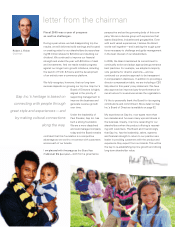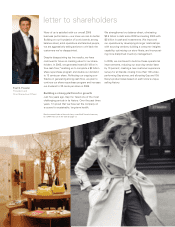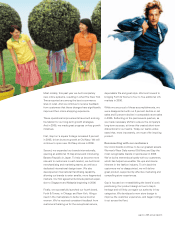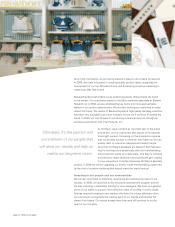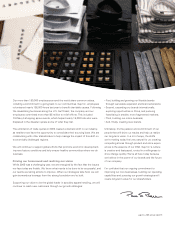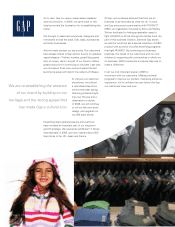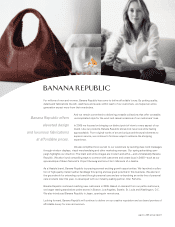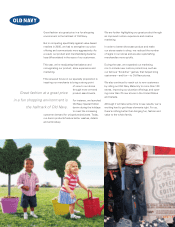Banana Republic 2005 Annual Report Download - page 13
Download and view the complete annual report
Please find page 13 of the 2005 Banana Republic annual report below. You can navigate through the pages in the report by either clicking on the pages listed below, or by using the keyword search tool below to find specific information within the annual report.
gap inc. 2005 annual report
11
In 2005, we approached our social responsibility
efforts with the same level of energy and commit-
ment that we applied to other aspects of our
business, investing generously in a variety of
programs that are helping to strengthen both our
company and the many communities we serve.
Creating Better Working Conditions
in Garment Factories
As a major apparel retailer, improving working
conditions in garment factories approved to do busi-
ness with us continues to be one of our top priorities.
Our team of factory monitors, which remains among
the largest in the apparel industry, personally
inspected 96% of the factories authorized for Gap Inc.
production for all of last fi scal year. The team also
underwent extensive training to improve its ability
to fi nd violations, such as discrimination, that have
historically been hard to detect.
Through organizations such as the MFA Forum,
the Ethical Trading Initiative (ETI) and Social Account-
ability International (SAI), we continued working
with partners from the private, government and
non-governmental sectors to address some of the
garment industry’s most intractable challenges, such
as the need for a universal set of labor standards.
And perhaps most important, we took another step
toward building labor standards directly into our
business practices by piloting our new integrated
Vendor Scorecard, which will enable our sourcing
team to consider labor standards along with factors
such as speed and quality when determining where
to place orders.
Building Stronger Communities
In addition to our work in garment factories last year,
we used our unique reach and assets to provide help
and hope to communities in need around the globe.
Here in the United States, Gap Inc. contributed more
than $5 million in cash and clothing to hurricane relief
efforts. In addition to providing immediate assistance
to 1,300 employees, we created Old Navy’s Field
Trip 4 Fun, which offered fun-fi lled shopping sprees
in Old Navy stores to nearly 15,000 kids who were
displaced or otherwise affected by the storms.
And more than a year after the tsunami struck in
Southeast Asia, Gap Inc. employees on the ground
in Sri Lanka, India and other countries in the region
continued to work with local governments and relief
organizations to address basic needs and administer
the $2.3 million donation we made in 2004.
In total, Gap Inc. made more than $23 million in cash
and in-kind contributions last year, while employees
donated approximately 155,000 hours of their time
to causes they care about.
Protecting the Environment
In 2005, we announced our goal as a voluntary
member of the U.S. EPA’s Climate Leaders program
to reduce greenhouse gas emissions by 11 percent
per square foot between 2003 and 2008. We also
continued working with suppliers to monitor
wastewater from laundry facilities against the
apparel industry’s voluntary water quality guidelines.
social responsibility


